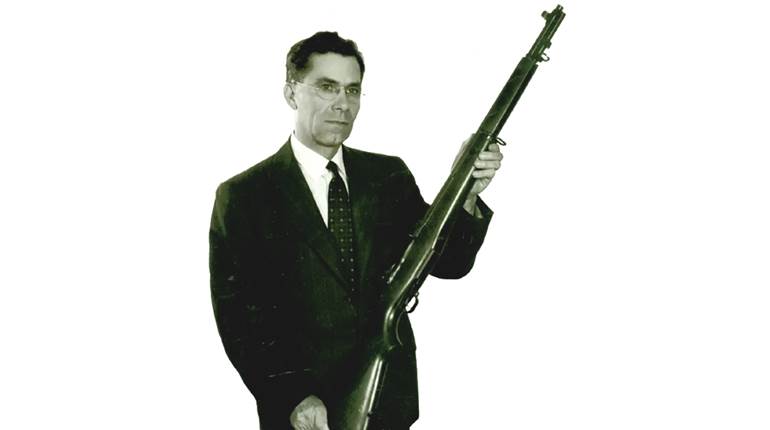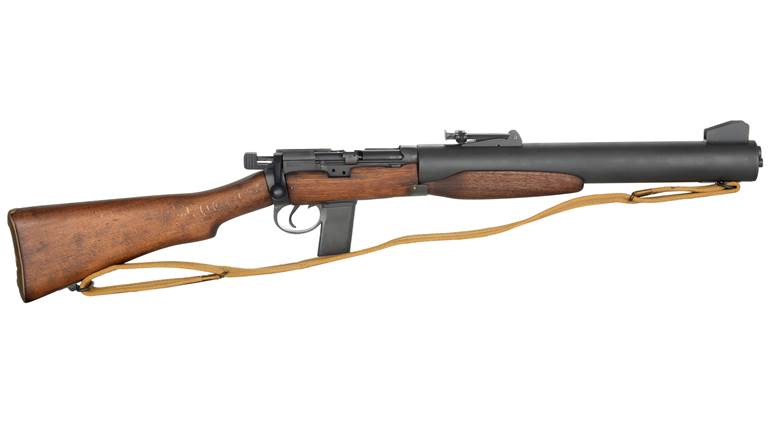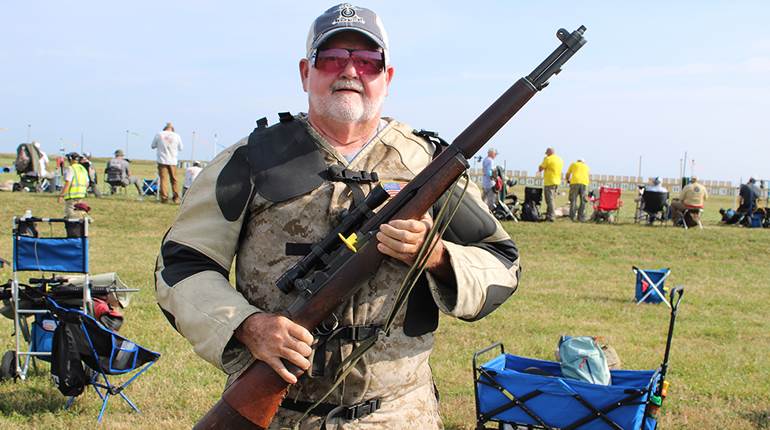
Top: The "Blitz Doughs" of the 36th Armored Infantry unit aboard a 3rd Armored Division M4 Sherman tank near Stolberg, Germany, fall 1944. National Archives photo
Spearhead: Painted by Gareth Hector. This scene depicts the famous T26E3 Pershing "Eagle 7" that destroyed a Panther tank at the Cologne cathedral on March 6, 1945. In the background are the "Blitz Doughs" of the 36th AIR, including Buck. Credit: ValorStudios.com
Most people who think about American forces fighting in Europe recall the big events that have been immortalized countless times in histories and by Hollywood: North Africa, Italy, Normandy, Market Garden, and the heroic stand around Bastogne during the Battle of the Bulge. For many, the narrative ends there, but the Reich did not go quietly after its loss at the Bulge. The final 100 days of the war required a combined sacrifice of American tanker crews and armored infantry pushing into the final holdouts of German forces, which still possessed significant combat capability and fanatical spirit. 
The experiences of these tankers and the infantry that fought with them in the war’s final months are the focus of bestselling author Adam Makos’ new book, Spearhead. One of the perspectives portrayed in the book is that of Sgt. Malcolm “Buck” Marsh Jr. and of how he came by several war trophies during the push deep into the Fatherland.
Marsh was a native of Florence, Ala., and attended Tennessee Polytechnic Institute prior to being called into service. He had also been a captain of the tennis team and was a fast runner, a skill that would later prove invaluable. By the end of December 1944, the then 22-year-old Private First Class (PFC) was assigned as a rifleman attached to A-Company of the 36th Armored Infantry Regiment. He was one of 19 replacements rushed to the unit still dug in at the snowy Ardennes. As an armored infantryman he and the rest of the “Doughs,” as they were nicknamed, were responsible for moving with and supporting the tanks of the 3rd Armored Division as they pushed East into enemy territory. This was a dangerous and grueling task even at this late stage of the war.
The first of Marsh’s trophies is connected with his first close encounter with the enemy during the first week of January 1945. With the ground covered in deep snow and the frigid air, it was a miserable situation even for those layered in clothing. Marsh soon learned that his adversaries had it even worse. One night while he and his foxhole buddy PFC Bob Janicki went to relieve the previous shift in a machine gun position, they passed by two shadowy figures walking the opposite direction. Believing these two to be the guys they were supposed to relieve, they paid little mind to the figures they passed. That is, until they got to the post and discovered the men they were supposed to relieve were still there.
Buck's Third Platoon, A-Co., 36th AIR, 3rd Armored Division, in Cologne, March 1945. Buck is kneeling, third from right. Photo courtesy Malcolm "Buck" Marsh
As it turned out, the two figures were exhausted Germans who had given up and walked up to the bunkhouse from where Marsh and Janicki had come. This caused quite a stir, but the two miserable Germans, one of whom had parts of his feet frozen into his boots, were allowed to stay inside. Later that night after getting off shift, Marsh sat across a table from the two Germans as he dug through a K-ration, leaving aside a can of processed cheese, which he did not like. When one of the Germans pointed at the cheese, Marsh agreed and gave the can to the soldier.  Yet Marsh soon found himself in a potentially scary position when the German produced an 8” Hitler Youth blade from his boot. As the German pulled out the knife, Marsh eyed and slowly reached for his M1 Garand that was sitting on the wall, anxious about whether he would be able to turn of the safety fast enough. However, the German used the blade to open the cheese and split it between him and his comrade, both of whom scarfed it down. They were clearly starving. In thanks, the German then gave the knife and scabbard over to Marsh, which he still has to this day.
Yet Marsh soon found himself in a potentially scary position when the German produced an 8” Hitler Youth blade from his boot. As the German pulled out the knife, Marsh eyed and slowly reached for his M1 Garand that was sitting on the wall, anxious about whether he would be able to turn of the safety fast enough. However, the German used the blade to open the cheese and split it between him and his comrade, both of whom scarfed it down. They were clearly starving. In thanks, the German then gave the knife and scabbard over to Marsh, which he still has to this day.
Marsh’s next trophy is connected to his first up-close experience of the reality of combat. On March 2, 1945, he and the rest of A-Company had split from the tanks and were pushing through a wooded area near Oberaussem, Germany. This was during the 3rd Armored Division’s push toward the German city of Cologne and the Rhine. Marsh had volunteered for the most dangerous role in the group, first scout. As first scout Marsh moved at the front of the group looking for the enemy, the literal tip on the spear. They came upon an opening in the trees where a hunting lodge sat across a narrow bridge that spanned a stream. Underneath a tree in front of the lodge, Marsh spotted a dug out fighting position with a German helmet sticking up. An enemy soldier peered out of the position to look around and then sank back down. Immediately after, an MG-42 opened up with two bursts from the position into the woods, but luckily in the wrong direction. This machine gun was a serious threat to the men of A-Company, who would have to rush into its line of fire to cross the bridge. After firing, the German soldier lifted his head to look out again. Marsh steadied his M1 off a tree and took aim at the German’s helmet, then fired.
Two "Blitz Doughs" (36th AIR) during the assault on Cologne. Photo: National Archives
After calling in mortar support, Marsh and the rest of A-Company rushed across the bridge and encircled the position, but quickly discovered that it was empty. Marsh noticed a trail of blood, and followed it toward the entrance to the lodge’s cellar. Inside, Marsh discovered several Germans gathered around a body lying on the ground. It was the man that he shot, the same age as him, and still alive despite being shot through the head. Seeing the result of his work up close unsettled Marsh, and his friend Janicki took notice. In an effort to ease Marsh’s mind, Janicki told him that he just happened to fire first, and that he saved the lives of his fellow Doughs that would have otherwise charged into the jaws of the machine gun. To further distract him, Janicki urged Marsh to help him search the lodge, which contained gun cabinets, and told him that he should pick one out to send home to his brother.
The "Blitz Doughs" (36th AIR) as they advance into Cologne with the iconic cathedral in the distance. Photo: National Archives

The "Blitz Doughs" (36th AIR) as they advance into Cologne on the back of a Sherman tank. Photo: National Archives
Marsh picked out an interesting triple barrel rifle-shotgun hybrid from the case with ornate engravings, beautifully shaped wood, and the owner’s animal count tallied up on the right side of the butt with brass pins. This hybrid, a Drilling combination gun, includes two upper 16-gauge shotgun barrels with a single 8 mm JR barrel underneath. This design includes the ability to change out the rifle barrel for another caliber or leave it off to use as just a shotgun, per Adolph Frank’s 1894 patent. Other interesting features of the Drilling include an integrated trap-door storage compartment for spare rifle cartridges in the butt, a peep sight tower for use as a rifle that folds into the grip, dual triggers, dual exposed hammer ears, and a selector for the two different modes in the place where the breech lever is on more traditional designs. The engravings are handmade with exquisite detail and the fit along with finish shows off the skill of the gunsmiths who made it. Marsh kept the Drilling tucked away in their half-track and hunted with it on many occasions after the war.





As the 3rd Armored Division along with Marsh’s company moved through the suburbs and into the ruined urban areas of Cologne, the danger increased. Allied bombing had reduced the buildings into rubble and clogged the streets, forming perfect defensive positions and road blocks. German snipers and anti-tank teams lay in wait to fight delaying actions as the American forces pushed toward the city center. They soon discovered that the enemy they faced ranged from reservists who were forced into the fight to seasoned and fanatical troopers who would make the Americans pay dearly for every step they took. Much of the fighting was room to room as the Doughs had to clear out buildings along the street as the tanks moved forward. As they moved deeper into the city center they came to an open plaza where the railway station stood. While Marsh moved along the partial cover of a railway platform, a German machine gun opened up with its sights set on him. This was where his experience as a fast runner came in handy. He ran as fast as his legs could carry him while rounds snapped directly behind him, barely.
The "Blitz Doughs" as they protect the advancing 3rd Armored Shermans. Foreground soldier carries a .30-cal. machine gun. Photo: National Archives
Once he reached the end of the platform and was out of sight from the machine gun, Marsh moved into the large waiting room of the station alone. The station had church-like pews for waiting passengers and there were small huts at the rear. As he looked around, Marsh spotted a pair of German officer’s boots sticking up from one of the pews. After looking around to make sure there were no signs of others, Marsh moved toward the pew to investigate. He found a German Captain laying in the pew dressed in full uniform. Marsh hit the back of the pew with his M1 and the officer promptly rose and spun around with his hands up, clearly ready to surrender.

Buck's squad in Cologne, shortly after conquering the city, early March 1945. Buck is without a helmet, holding his M1 Garand. Right, this A-Company half-track belonged to Buck's squad. Photo credit: Malcolm "Buck" Marsh
As the officer spoke to Marsh in English to tell him that there were no soldiers in the huts, Marsh searched him and removed a leather pistol holster from his hip. Inside was a P-08 Luger, 1939 S/42 code with the holster also marked 1939. Later on, Marsh and his comrades would take turns shooting it during their down time at German helmets they situated in the road for target practice. Marsh noted that the recoil of the 9 mm Luger was more controllable than the .45 ACP M1911A1, and penetrated the helmets easier. Marsh carried this Luger as a combat sidearm, until he overheard rumors that GIs found with Lugers by the Germans ended up with their trophies shoved down their throats and fired. At this point Marsh stopped carrying the Luger and found a P-38 Walther to use instead. The Luger and its holster, both in good condition, came home with Marsh after the war, and he would shoot it on occasion.

By the last day of the war, Marsh and his company were at the West bank of the Elbe River where countless German soldiers, personnel, and civilians began to flood across to avoid the Soviets. One of the boats that came across carried two well-dressed female German soldiers in gray jackets and slick dark grey ski pants. They had large smiles on their faces, happy to be surrendering to the Americans instead of the Russians. This was an unusual sight for the Americans, who took turns offering compliments and cigarettes. 
While Marsh sat at a table, he looked at one of the female soldiers and noticed that her ski pants side pocket had a bulge. Marsh motioned her to come over and when she did, he pointed toward her pocket. She promptly reached into her pocket and pulled out a .25 caliber “Dušek” Czech pistol—a close copy of the “Baby Browning” handgun—with a loaded magazine. She smiled, apparently surprised that someone had just noticed it. She dropped it into Marsh’s palm and walked off once he motioned that he was satisfied. This would be the final trophy Marsh secured during the war.
Today Buck Marsh, 95, and his wife live in Opelika, Ala.—near Auburn University, which he attended after the war. After graduating, he built a successful construction company, and is now retired. He enjoys a large family of many children, grandchildren and great grandchildren. An avid outdoorsman all of his life, Marsh still participates in occasional recreational shooting and hunting.
Recently, I had the opportunity to shoot with Mr. Marsh and decided to bring along my M1. When all the guns were laid out, he immediately noticed the M1 and lost interest in all the other choices. He excitedly walked to the firing line with it and fired off a round from the hip, saying with a laugh, “It kicks more than I remember.” His grandson asked why he shot it from the hip, to which Mr. Marsh replied, “We learned to shoot from the hip; you don’t have time to aim when you’re running to cover and getting shot at.” This was the first time that he had held or fired a M1 since the 1940s, yet he handled it as if the past seven decades never happened. Afterwards, he walked around with it tucked under his arm just as he did in 1945. A rifleman to this day. His story is just one of the many chronicled in Adam Makos’ new book about the fighting doughs and their tanker counterparts as they pushed deep into the Reich during the final days of the war. The stories of these brave men, especially those like Buck Marsh, are ones that we as Americans must cherish and most certainly never forget. 











































